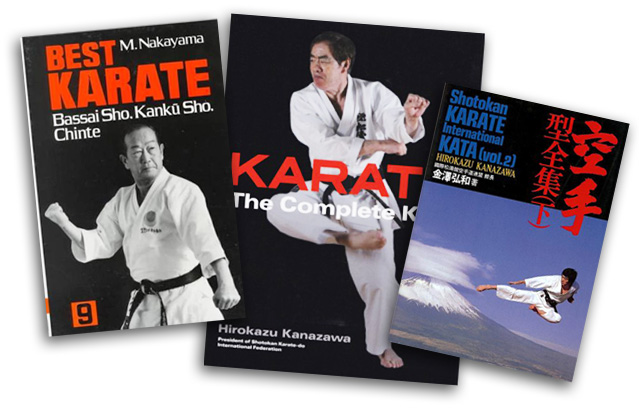When it comes to Shotokan Karate, nothing beats live-training in the dojo. No book will ever replace a knowledgeable sensei and the chance to train face-to-face, still, there are books to dramatically improve your Karate techniques and knowledge. Let’s find out, today, some of the best karate books in the history. Feel free to share, in the comments, more books, if you know and recommend them:
Best Karate Books – Shotokan and Related Karate Styles
Dynamic Karate by Masatoshi Nakayama
This is the big book, some times known as “The big Orange”. It has good pictures and descriptions of all the basic techniques. Master Nakayama was for many years the head instructor of the Japan Karate Association. It provides a guide with answers and examples to those techniques already introduced in the dojo. It also provides descriptions of the right way and the wrong way to perform techniques. Your basic reference book and a standard for any Shotokan library.
Shotokan Karate Free Fighting Techniques by Sensei Enoeda and Charles Mack
A richly illustrated guide to free fighting techniques of Shotokan karate by two leading martial artists, this text takes any beginner through the basic techniques of the art, and step-by-step photographs and clear, detailed captions, aim to ensure that the “meaning” of the technique is clear.
The KUGB Guide to Better Karate by Bob Poynton
Illustrated throughout by over 550 B&W photos of champions in training and Sensei Eneoda in action, covering all aspects of karate from its fundamental philosophy to modern day competition. Out of print at the moment but you may be able to find one through Ebay now and again.
Shotokan Karate: 10th to 6th Kyu: by Sensei K Enoeda
This volume takes the student from the 10th kyu or White Belt to 6th kyu or Green Belt. Each section is divided into separate levels for the relevant kyu grade, incorporating appropriate techniques, sparring and kata.
Shotokan Karate: 5th Kyu to Black Belt by Sensei Enoeda
This volume takes the student from the 5th kyu or Purple Belt to Black Belt. Each section is divided into separate levels for the relevant kyu grade, incorporating appropriate techniques, sparring and kata.
Shoto-Kan: Advanced Kata by Sensei Enoeda
An excellent book for the advanced Black Belt. “The Tiger” himself shows the steps to 5 katas. Tekki-Nidan, Tekki-Sandan, Nijushiho, Gojushiho-Dai, Gojushiho-Sho. He even shows changes to Tekki-Sandan from the original kata. Definitely a book to keep for the a student/teacher of Shotokan!
Best Karate: Comprehensive by Masatoshi Nakayama
The book is well illustrated, and gives an excellent introduction into the different stances and strikes found in Karate. More importantly, it is probably the only book that illustrates the “flow” of the moves, instead of just showing the ends of the move.
Best Karate: Fundamentals by Masatoshi Nakayama.
This volume is one of a series presenting all karate and “kumite” practiced by the Japan Karate Association. Each chapter contains photographs of an instructor of the association executing a certain technique.
Best Karate: Kumite 1 by Masatoshi Nakayama.
Best Karate: Kumite 2 by Masatoshi Nakayama.
Best Karate: Heian, Tekki by Masatoshi Nakayama
Covers all 5 Heian and 3 Tekki katas which get the beginner a long way.
Best Karate: Bassai, Kanku by Masatoshi Nakayama
Best Karate: Jutte, Hangetsu, Empi by Masatoshi Nakayama
Best Karate: Gankaku, Jion by Masatoshi Nakayama
Best Karate: Bassai Sho, Kanku Sho, Chintei by Masatoshi Nakayama
Best Karate: Unsu, Sochin, Nijushiho by Masatoshi Nakayama
Karate-do Nyumon: The Master Introductory Text by Gichin Funakoshi, John Teramoto (Translator)
This introduction to karate teaches both the physical training and the mental philosophy necessary for karate mastery.
Karate-do Kyohan: The Master Text by Gichin Funakoshi, Tsutomu Ohshima (Translator)
Written by the founder of Shotokan Karate
Moving Zen: Karate as a Way to Gentleness by Clive Nicol
In 1962 twenty-two-year-old Clive, born in Wales, arrives in Japan study Karate, training at the JKA headquarters. He shortly finds that the study of this martial art engages his whole being and transforms his outlook on life. This is an updated volume from the original issued in 1975 with a new foreword and after note by the author.

